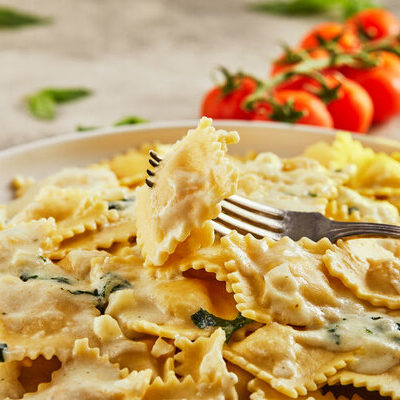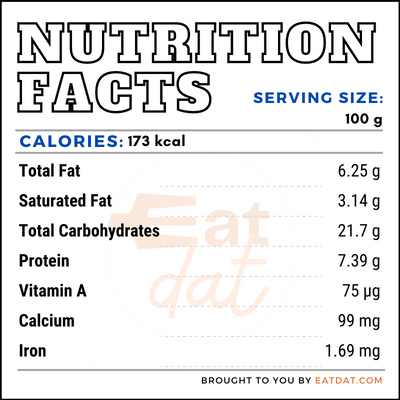
Ravioli
What is Ravioli?
Ravioli is a type of pasta that is stuffed with a savory or sometimes sweet filling. The stuffing may include cheese, meat, nuts, and vegetables, covered by a thin layer of pasta dough. The dish is generally served hot with a sauce or broth. The word itself can be directly translated into ‘wrap’ and comes from the Italian word ‘riavvolgere’.
- This pasta is generally served as a main course but can be served as an appetizer when served without a sauce.
- Also, ravioli can be purchased pre-made or frozen. In the US, National Ravioli Day is celebrated on 20th March every year.
Some popular stuffed pasta brands include:
- Good & Gather
- Kite Hill
- Cappello’s
- Udi’s
- 365 Whole Foods Market
- Wegmans
- Great Value
Origin of ravioli
Pasta has a long history. It is an Italian dish but has its origin in the Chinese noodles. There is archaeological evidence to suggest that the Chinese were making noodles as far back as 4000 years ago. Stuffed pasta first originated in Italy in the 1400s in the royal courts of Milan and Mantua. Some traditional fillings include almonds and pumpkin, or meat stuffing with ragù sauce.
One of the earliest written mentions of the dish is by Francesco di Marco Datini, who gives a recipe for a stuffing made from chopped blanched green herbs, fresh cheese, and beaten egg. Also, the recipe can be found in a cookbook written by the chefs of Richard II of England in the 14th century!
Nutrition
Nutritional profile for cheese ravioli (100 gms):

Ravioli is high in sodium and potassium. Additionally, it contains calcium, phosphorous, magnesium, selenium, folate, folic acid, choline, vitamin A, retinol, lutein + zeaxanthin, and fatty acids in decent quantities.
The main ingredient in the pasta covering is wheat, which must be avoided by those with a gluten allergy. All pasta is made from durum flour, which has a lower glycemic index than regular flour. Cold pasta is a good source of resistant starch. This makes it a dish that can help control obesity, diabetes, and heart problems. Research shows that regular pasta eaters follow dietary patterns that give them higher amount of fiber and show an increased HEI (Healthy Eating Index).
Commercial production
The first step to prepare pre-packaged ravioli is to sieve the flour and knead it into a dough. Then, the vegetables are cleaned thoroughly and chopped into small pieces before going through a process to extract water from them. Any meat is also ground and spices are mixed into the filling. After that, a machine is used for the purpose of shaping the ravioli and stuffing it with the filling. Stuffed pasta made in restaurants or at home may also use a machine or it may be done by hand. The pasta is finally packaged and ready for distribution.
Ravioli recipes
Ravioli can be of different shapes and can come with a variety of stuffings and sauces. Other pasta types similar to ravioli include tortelli, tortellini, pansotti, agnolotti, and cjarsons, depending on their shapes. Here are a few recipes:
- Four Cheese Ravioli
- Tortelli di Zucca
- Casoncelli Alla Bergamasca
- Tortelli Mugellani
- Ricotta and Spinach Ravioli
- Tordelli Lucchesi
- Uovo in Raviolo
- Casunziei all’ampezzana
- Turle le Mendatica
- Cjarsons di Pontebba
- Ofelle alla Triestina
FDA regulations
The FDA classifies pasta under macaroni products, which is defined as food prepared by drying units of dough made from semolina, durum flour, farina, flour, or a combination of these with water and other optional ingredients. These products are regulated strictly in the US for the seasonings, salt, gluten content, disodium phosphate, etc. The finished product must be at least 87% solid. The labeling of these products must include these specifications clearly.
References
Ravioli: An Appreciation, Cucina Toscana, https://toscanaslc.com/blog/ravioli-an-appreciation/
Bianca Ackroyd, The History of Ravioli: A Timeless Italian Tradition, Culture Trip, https://theculturetrip.com/europe/italy/articles/ravioli-a-timeless-italian-tradition/
Papanikolaou, Yanni. “Pasta Consumption Is Linked to Greater Nutrient Intakes and Improved Diet Quality in American Children and Adults, and Beneficial Weight-Related Outcomes Only in Adult Females.” Frontiers in nutrition vol. 7 112. 7 Aug. 2020, doi:10.3389/fnut.2020.00112, https://www.ncbi.nlm.nih.gov/pmc/articles/PMC7426435/
Fulgoni, Victor L 3rd, and Regan Bailey. “Association of Pasta Consumption with Diet Quality and Nutrients of Public Health Concern in Adults: National Health and Nutrition Examination Survey 2009-2012.” Current developments in nutrition vol. 1,10 e001271. 19 Sep. 2017, doi:10.3945/cdn.117.001271, https://www.ncbi.nlm.nih.gov/pmc/articles/PMC5998777/
